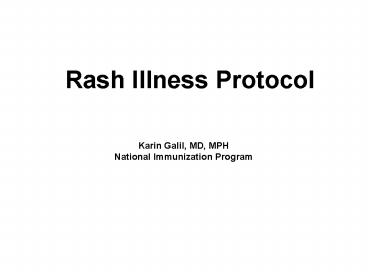Rash Illness Protocol - PowerPoint PPT Presentation
1 / 31
Title: Rash Illness Protocol
1
Rash Illness Protocol
Karin Galil, MD, MPH National Immunization Program
2
Generalized Vesicular or Pustular Rash Illness
Protocol
3
RISK OF SMALLPOX BY
CLINICAL HISTORY AND EXAMINATION High Risk
for Smallpox Febrile prodrome and gt2 other major
smallpox criteria?REPORT IMMEDIATELY
Moderate Risk Febrile prodrome and 1 other major
and gt2 minor smallpox criteria? EVALUATE
URGENTLY Low risk No major smallpox
criteria?manage as clinically indicated
- Significant viral prodrome occurring 1-4 days
before rash onset fever gt101 and at least one of
the following prostration, headache, backache,
chills, vomiting or severe abdominal pain. All
smallpox patients have a prodrome. The fever may
drop with rash onset. - Lesions are deep, firm/hard, round,
well-circumscribed may be umbilicated or
confluent - On any ONE part of the body (I.e. the face, or
the arm) lesions are all in the same stage of
development - Greatest concentration of lesions on face and
distal extremities (centrifugal)
- Lesions first appeared on oral mucosa/palate,
face, forearms - Patient appears toxic or moribund
- Lesions evolve from macules to papules?pustules
over days - Lesions on the palms and soles
Major Criteria
Minor Criteria
4
Common Conditions With Vesicular or Pustular
Rashes
5
Variant presentations of smallpox approximately
of persons never vaccinated for smallpox will
present with hemorrhagic smallpox in 3-5 (see
photo-- can be mistaken for meningococcemia,
hemorrhagic varicella, Rocky Mountain spotted
fever, erlichiosis, acute leukemia) or flat-type
smallpox in 5-7 (see photo). Both variants are
highly infectious and carry a high mortality.
Smallpox in previously vaccinated individuals
may present with milder prodrome, fewer lesions
and less systemic illness (more likely to be
mistaken for chickenpox). Little is known about
the presentation of smallpox in severely
immunocompromised persons.
6
Varicella in a Healthy Adult
7
Varicella infected lesions
8
Varicella in Pregnancy
9
(No Transcript)
10
Herpes zoster
11
VARICELLA
12
(No Transcript)
13
Varicella
14
Varicella in a leukemic child with encephalopathy
15
Smallpox
Day 3 Day 5
Day 7
Chickenpox
16
(No Transcript)
17
Drug Rash
18
Eczema herpeticum
19
Herpes simplex
20
Bullous pemphigoid
21
Secondary syphilis
22
Molluscum contagiosum
23
Hand, Foot and Mouth
24
Hand, Foot And Mouth Disease
25
Scabies
26
Eczema herpeticum
27
Hemorrhagic Varicella
28
Hemorrhagic Varicella
29
Hemorrhagic Rashes Meningococcemia
30
Meningococcemia
31
- Laboratory Testing for Varicella
- Direct fluorescent antibody (DFA)rapid, depends
on adequate specimen - Serologic testing an IgG (collected at time of
rash) provides evidence of prior varicella, and
makes acute varicella infection unlikely but does
not rule out herpes zoster in persons at risk of
dissemination. IgM is not useful for diagnosis. - Polymerase chain reaction (PCR) (available in
research labs, some tertiary care centers) - VZV cultureresults delayed, useful only if
processed in-house - Electron microscopy (EM)cannot distinguish VZV
from HSV - How to Collect a Specimen for Direct Fluorescent
Antibody (DFA) Testing - Unroof (open) vesicle or pustule with a sterile
lancet - Swab base of vesicle vigorously with a sterile
swab - Smear swab onto 3 areas (or wells) of a
microscope slide - Allow slide to air dry
- Transport to lab for immediate fixing and
staining - VZV positive specimens are seen with varicella
(chickenpox) and herpes zoster (shingles) - The hospital lab performs _________________ test
- For DFA, call ________________ (specimen is
tested at outside lab)































